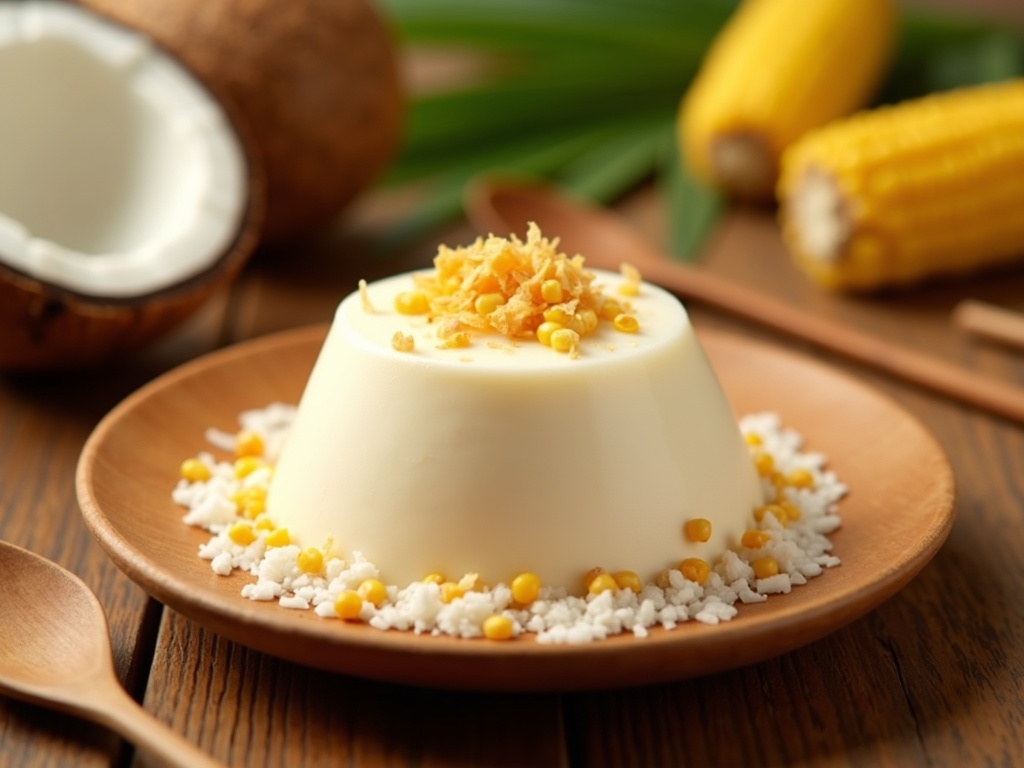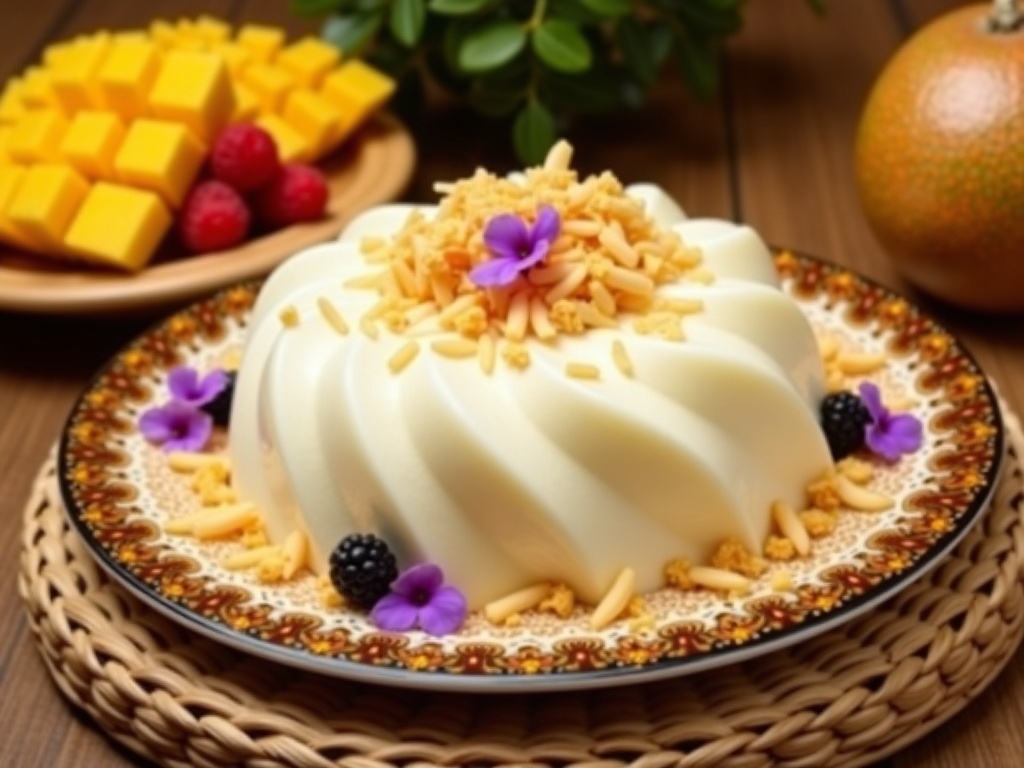Maja blanca recipe, a beloved Filipino coconut pudding dessert, combines the creamy richness of coconut milk with the subtle sweetness of corn to create a pudding-like delicacy that’s perfect for celebrations. This traditional “white delicacy” holds cultural significance dating back to the Spanish colonial period, offering a moderate dessert option with approximately 300 calories per serving that I’ve found perfect for family gatherings year-round.
Find In This Article
Key Takeaways
- Traditional maja blanca requires only a few ingredients: coconut milk, corn kernels, sugar, cornstarch, and salt, with optional toppings like latik (toasted coconut curds).
- Constant stirring while adding the cornstarch slurry to the simmering mixture is crucial for achieving the perfectly smooth consistency that defines this dessert.
- When properly stored in the refrigerator, maja blanca stays fresh for up to 5 days and can be frozen for up to 2 months when wrapped properly.
- The dessert offers nutritional benefits from its coconut milk base, which provides healthy fats and dietary fiber that aids digestion.
- Maja blanca’s cultural significance extends beyond its ingredients, appearing at virtually every important Filipino celebration as a symbol of Filipino hospitality.
The Perfect Filipino Coconut Pudding Dessert
Maja blanca holds a special place in Filipino cuisine as a creamy, delightful dessert that’s become a staple at family gatherings and celebrations. This beloved “white delicacy” (as its Spanish name translates) combines the richness of coconut milk with the subtle sweetness of corn and sugar to create a pudding-like dessert that’s both satisfying and refreshing.
I’ve found that traditional maja blanca offers more than just fantastic flavor. Each serving contains approximately 300 calories, making it a relatively moderate dessert option compared to heavier alternatives. The coconut milk base provides healthy fats that can actually benefit your body when enjoyed in moderation. Plus, the dietary fiber content helps balance the sweetness and adds nutritional value to this treat.
Key Ingredients and Nutritional Benefits
The magic of maja blanca comes from its simple yet flavorful ingredients that work together perfectly:
- Coconut milk: Provides the signature creamy texture and contains medium-chain triglycerides (MCTs) that are easily digested
- Sweet corn kernels: Adds texture and natural sweetness while contributing essential vitamins
- Sugar: Balances the flavors and creates the right level of sweetness
- Cornstarch: Acts as the thickening agent that gives the dessert its pudding-like consistency
During the Christmas season in the Philippines, you’ll rarely find a celebration table without this classic Filipino dessert making an appearance. The white color of maja blanca makes it particularly festive during the holidays, often garnished with toasted coconut or latik (fried coconut curds) for added texture and flavor.
I’ve discovered that maja blanca pairs wonderfully with other Filipino desserts like leche flan for a contrasting texture experience. The coconut flavor profile also complements tropical drinks such as a refreshing coconut shake for a complete taste of Filipino cuisine.
The versatility of maja blanca makes it suitable for almost any occasion. While traditionally served chilled as square or diamond-shaped pieces, modern interpretations include layered versions or even maja blanca topped with fruit compotes for added flavor dimensions. This adaptability has helped maintain its popularity across generations of Filipino families both in the Philippines and abroad.
Essential Ingredients and Step-by-Step Guide
Making maja blanca at home requires just a few simple ingredients that combine to create this beloved Filipino coconut pudding. I’ve made this dessert countless times, and the silky texture makes it a perfect ending to any meal.
Here’s everything you’ll need to create this classic dessert:
- 2 cups coconut milk
- 1 cup corn kernels
- 3/4 cup sugar
- 1/2 cup cornstarch
- 1/8 tsp salt
- Optional toppings: latik (toasted coconut curds), grated coconut, or condensed milk
Preparing Your Maja Blanca
I start by mixing the cornstarch with a small amount of coconut milk in a bowl, stirring until I’ve created a smooth slurry without any lumps. This initial step is crucial for preventing clumps in the final dessert.
In a saucepan over medium heat, I combine the remaining coconut milk, sugar, and salt, stirring until the sugar dissolves completely. Once the mixture is warm, I add the corn kernels and let everything simmer for about 5 minutes.
The next step requires attention – I slowly pour the cornstarch slurry into the simmering mixture while continuously stirring. This is where many people go wrong. Constant stirring prevents lumps from forming and helps achieve that perfectly smooth consistency that makes Filipino desserts so special.
The mixture will begin thickening quite quickly, usually within 3-5 minutes. I continue cooking and stirring for another 5 minutes until the mixture resembles a thick pudding that coats the back of a spoon. The total cooking time shouldn’t exceed 15 minutes.
For a silky-smooth texture, I keep these tips in mind:
- Stir in one direction to minimize air bubbles
- Use a wooden spoon or flexible spatula to reach all areas of the pot
- Lower the heat if the mixture thickens too quickly
- Don’t stop stirring, even for a moment
Once thickened, I immediately transfer the mixture to a greased mold or baking dish. The surface can be smoothed with a wet spatula to create a flawless finish, similar to when making a leche flan.
Allow the maja blanca to cool completely at room temperature before refrigerating for at least 3 hours, though overnight setting yields the best texture. Once set, the pudding should have a firm but jiggly consistency that holds its shape when sliced.
Before serving, I often add a traditional topping of latik, which complements the coconut flavors beautifully and adds a delightful crunch to each creamy bite.
Cultural Heritage and Significance
Maja blanca stands as one of the most beloved traditional Filipino desserts that I’ve encountered throughout my culinary journey. This creamy coconut pudding represents more than just a sweet treat—it embodies Filipino culture and history on a plate. Its popularity at celebrations speaks volumes about its cultural importance.
The origins of maja blanca can be traced back to the Spanish colonial period in the Philippines, which lasted for over three centuries. During this time, Spanish culinary techniques merged with local Filipino ingredients, creating this unique dessert. The Spanish introduced milk-based desserts and cooking methods, while Filipinos contributed their abundant local ingredients.
A Fusion of Local Ingredients and Foreign Influence
What makes maja blanca distinctly Filipino is its clever use of indigenous ingredients. The dessert primarily features coconut milk (gata) extracted from mature coconuts, highlighting the Philippines’ natural abundance of this tropical fruit. The classic recipe also incorporates corn kernels, another staple in Filipino agriculture, giving the dessert its signature texture and subtle sweetness.
The cultural significance of maja blanca extends beyond its ingredients. This dessert appears at virtually every important Filipino celebration:
- Fiestas and town celebrations feature maja blanca as a centerpiece dessert
- Family gatherings often include this pudding as a crowd-pleasing favorite
- Christmas and New Year celebrations consider maja blanca an essential part of the dessert spread
- Birthday parties and baptisms showcase this dessert as a symbol of Filipino hospitality
I’ve noticed that maja blanca’s significance to Filipino culture mirrors other beloved desserts like creamy leche flan that grace celebration tables. Its presence at special events reinforces community bonds and cultural identity through shared culinary experiences.
The dessert’s name itself reveals its colonial influences—”maja” comes from the Spanish word “manjar,” meaning delicacy, while “blanca” means white, referring to its characteristic pale appearance. This linguistic heritage preserves the memory of cultural exchange that shaped Philippine cuisine.
Beyond family gatherings, maja blanca has evolved into a commercial product sold in markets and restaurants throughout the Philippines. Some innovative chefs have created modern variations with additional flavors like fragrant pandan or topped with latik (toasted coconut curds) for extra texture and flavor.
The preparation of maja blanca also holds cultural significance. The process of extracting fresh coconut milk by hand demonstrates traditional Filipino food preparation techniques passed down through generations. Though modern conveniences have simplified the process, many families still value the traditional methods for special occasions.
As Filipino communities have spread globally, maja blanca has traveled with them, becoming an ambassador of Filipino culture abroad. It’s now enjoyed in Filipino restaurants and homes worldwide, introducing non-Filipinos to the sweet flavors of the Philippines.
The lasting popularity of maja blanca in Filipino dessert traditions speaks to its perfect balance of flavors, textures, and cultural significance. It represents not just culinary heritage but also the Filipino value of sharing food as an expression of love and community—a sweet testament to the enduring spirit of Filipino culture through its cuisine.

Serving and Presentation Tips
Once I’ve prepared a perfect batch of maja blanca, the finishing touches make all the difference between an everyday dessert and a showstopper. This classic Filipino coconut pudding yields 8 generous servings from a standard recipe, making it perfect for family gatherings or small parties. The smooth, creamy texture and subtle coconut flavor deserve presentation that honors this beloved Filipino dessert.
Elegant Presentation Ideas
I always serve maja blanca chilled for the best texture and flavor experience. After setting in the refrigerator for at least 4 hours, the pudding reaches the perfect consistency – firm enough to hold its shape when sliced but still delightfully creamy on the palate. The star garnish is unquestionably the latik (toasted coconut curds) sprinkled generously on top, adding a beautiful contrast in both color and texture.
For everyday serving, I simply cut the maja blanca into diamond or square shapes and arrange them on a serving platter with latik scattered across the top. For special occasions, I take the presentation up a notch with these garnishing ideas:
- Fresh fruit accents like thin mango slices or berries create vibrant color contrast
- Coconut curls or toasted desiccated coconut for added texture
- Edible flowers for elegant celebrations
- A light dusting of cinnamon or nutmeg for subtle flavor enhancement
- Mint leaves for a pop of fresh green color
Maja blanca pairs beautifully with a strong cup of Filipino Barako coffee, creating a perfect balance between the creamy dessert and the bold coffee flavor. The slightly bitter notes of the coffee complement the sweetness of the pudding.
In traditional Filipino gatherings, I often serve maja blanca as part of a larger spread of sweet treats, particularly alongside other rice-based delicacies like puto (steamed rice cake) and various kakanin (Filipino sweet rice snacks). The white color of maja blanca creates a lovely visual contrast with colorful desserts like pandan-flavored treats on a dessert table.
For a more substantial dessert experience, I sometimes pair maja blanca with other coconut-based treats like refreshing coconut shakes or banana bread for a tropical-themed dessert spread.
When serving for guests unfamiliar with Filipino desserts, I place small identifying cards beside each treat with a brief description. This thoughtful touch helps guests appreciate the cultural significance of maja blanca as they enjoy its delicate flavors.
For individual servings at more formal occasions, I use small dessert glasses and layer the maja blanca with additional latik in the middle, creating a parfait-like presentation that showcases the different textures. A small slice of sweet treat on the side adds an interesting flavor combination.
The clean white appearance of maja blanca makes it an ideal canvas for seasonal decorations – red and green toppings for Christmas, pastel colors for spring celebrations, or golden accents for New Year festivities. No matter how it’s presented, this beloved Filipino dessert always brings smiles to the table with its comforting flavor and smooth, satisfying texture.
Expert Storage Guidelines
Keeping your maja blanca fresh and delicious beyond the day you make it requires proper storage techniques. I’ve found that with the right approach, this beloved Filipino coconut pudding can maintain its delightful texture and flavor for several days or even months.
Refrigeration and Freezing Options
When stored in the refrigerator, maja blanca stays fresh for up to 5 days. To maintain its quality, I always cover it tightly with plastic wrap or place it in an airtight container. This prevents the dessert from absorbing other flavors from the fridge and keeps it from drying out.
For longer storage, freezing is an excellent option. Properly frozen maja blanca can last up to 2 months without significant quality loss. I’ve discovered that the key to successful freezing lies in the preparation. Here’s how I handle the freezing process:
- Cut the maja blanca into individual serving portions before freezing
- Wrap each piece tightly in plastic wrap, then add a layer of aluminum foil
- Place the wrapped pieces in a freezer-safe container to prevent freezer burn
- Label the container with the date of freezing to track freshness
When it’s time to enjoy your frozen maja blanca, proper thawing makes all the difference. I recommend transferring the wrapped pieces from the freezer to the refrigerator and allowing them to thaw slowly overnight. This gradual thawing helps maintain the pudding’s original texture. For quicker results, you can thaw at room temperature for about 1-2 hours, but I find the refrigerator method yields better texture results.
Texture preservation is perhaps the trickiest part of storing maja blanca. This coconut-based dessert can sometimes release moisture after freezing, affecting its signature smooth consistency. To minimize texture changes, I gently pat the surface with a paper towel after thawing to remove any excess moisture.
If you notice slight separation or moisture on the surface after thawing, don’t worry—this is normal. The dessert will still taste delicious, though the texture might be slightly different from freshly made maja blanca.
For special occasions, I like to prepare maja blanca in advance and freeze it, which is a huge time-saver. This approach works particularly well when I’m planning to serve it alongside other Filipino desserts like leche flan or pandan cake.
Remember that the corn kernels commonly found in maja blanca might change slightly in texture after freezing, becoming a bit softer. If you’re planning to freeze your maja blanca, you might consider making it without corn or adding fresh corn as a topping after thawing.
When serving previously frozen maja blanca, I find that garnishing with fresh toppings like toasted coconut flakes or a light dusting of latik (toasted coconut curds) helps refresh the presentation and adds texture contrast. This simple touch makes the dessert look and taste freshly made, even if it’s been stored for some time.
By following these storage guidelines, you’ll be able to enjoy your maja blanca well beyond the day of preparation, making it an even more convenient and practical dessert to include in your recipe collection.
Nutritional Benefits and Dietary Information
Maja blanca offers numerous nutritional advantages thanks to its wholesome ingredients. This Filipino dessert combines the goodness of coconut and corn to create a treat that’s not just delicious but also packed with essential nutrients.
Health Benefits of Key Ingredients
The coconut components in maja blanca provide significant dietary benefits. I’ve found that the coconut milk used in this recipe delivers healthy fats that can support heart health when consumed in moderation. These medium-chain triglycerides (MCTs) are easily metabolized by the body and can provide quick energy. The dietary fiber from coconut helps improve digestion and promotes a feeling of fullness, which can be helpful for those watching their food intake.
Each cup serving of maja blanca contains approximately 300 calories, making it a reasonable dessert option when enjoyed as part of a balanced diet. What makes this dessert stand out nutritionally is its reliance on natural ingredients rather than artificial preservatives or flavors, allowing you to indulge without consuming unnecessary additives.
The corn in maja blanca contributes additional nutritional value, providing vitamins and minerals such as vitamin B, fiber, and antioxidants. Combined with the nutrients from coconut, maja blanca becomes more than just a sweet treat—it’s a dessert with actual nutritional merit.
Here are the primary nutritional components you’ll get from a typical serving of maja blanca:
- Healthy fats from coconut milk that support energy production
- Dietary fiber that aids digestion and gut health
- Essential vitamins and minerals from both coconut and corn
- Natural sugars that provide a healthier alternative to refined options
- Protein content (though modest) from the milk components
For those with dietary restrictions, maja blanca can be adapted to suit various needs. The traditional recipe can be modified to be dairy-free by using only coconut milk rather than adding condensed or evaporated milk. If you’re looking for other coconut-based treats that share similar nutritional profiles, you might enjoy trying a refreshing coconut shake that delivers comparable benefits.
The dessert pairs wonderfully with other Filipino classics like leche flan, though I’d suggest balancing such pairings with the overall caloric intake in mind. For those seeking variety in their dessert options, maja blanca fits nicely into a rotation with lighter options like banana loaf, which offers different but complementary nutritional benefits.
One notable aspect of maja blanca’s nutritional profile is its substantial mineral content derived from coconut. These include potassium, magnesium, and phosphorus—all important for maintaining proper cellular function and electrolyte balance. The dessert also contains small amounts of iron and zinc, contributing to its overall nutritional value.
For those monitoring sugar intake, it’s worth noting that the traditional recipe does contain added sugar, but this can be adjusted according to taste and dietary needs. The natural sweetness from corn and coconut milk allows for reducing added sugar without significantly impacting flavor.
If you’re exploring desserts with nutritional benefits, maja blanca stands out as an option that balances indulgence with nutritional merit. The combination of its rich, creamy texture and valuable nutrients makes it a worthy addition to your recipe collection.

Sources:
Maja Blanca: A Delicious Filipino Dessert – Filipino Cuisine Magazine
Traditional Filipino Desserts: Cultural Heritage and Recipes – Taste of the Philippines
History of Filipino Food and Its Spanish Influence – Journal of Ethnic Foods

